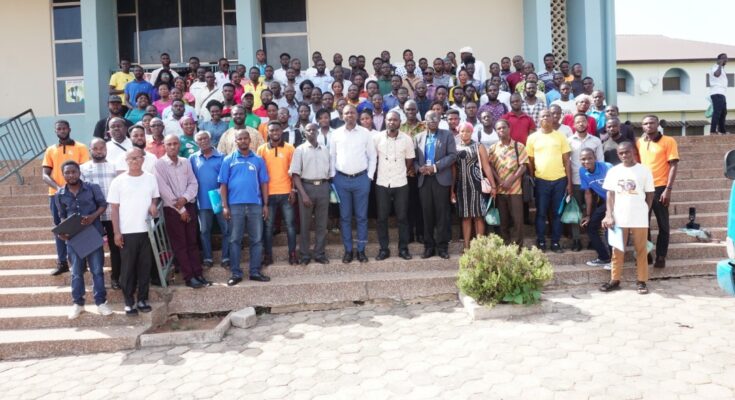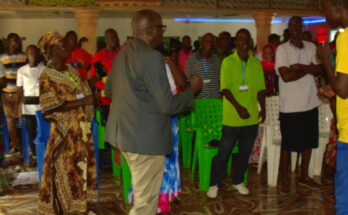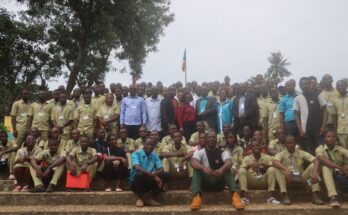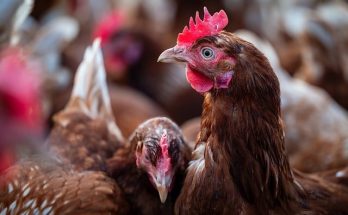The knowledge update on poultry health and nutrition held in Ghana recorded over 566 participants. The training was connected to Facebook Live through the Facebook page for the benefit of her members who were not physically present for the training in Kumasi (click on the links https://fb.watch/htltVaQ17_/ and https://fb.watch/htlwEsR1t2/). The program’s gender distribution was 34.3% female and 65.7% male. The training took place on December 6 and 8, 2022, respectively, in GNAT Conference Hall in Amakom, Kumasi, and at Asante, Mampong Prespy Church in Ghana. Together with the Zoetis Foundation, the training was organized to enhance livestock health while benefiting farmers’ livelihoods in Sub-Saharan Africa.
Mr. Joshua Olorungbemi, the current regional manager of Zoetis in West Africa, addressed the participants and gave a brief introduction to the company as well as the role it plays throughout all of Africa. He urges the attendees to pay close attention to the lectures the speakers will be delivering because doing so will help their poultry businesses. Other dignitaries, such as the district directors, also addressed the participants and encouraged everyone to attentively listen to the day’s lecturers in order to advance their poultry companies.
The keynote speaker at the event, Dr. Stephen Adejoro, discussed the need to go from a solo prevention and control strategy to a mixed strategy for bird flu (avian influenza). Avian influenza is a highly contagious viral illness that affects both domestic and wild birds, the speaker said as he began his lecture. It’s defined as a terrible viral disease that affects chickens and can spread to humans. He lists the following as the main causes of the spread of AI:
- Live Bird Market
- Wild Birds/Migratory Birds
Dr. Stephen talked about how migratory birds contribute to the spread of AI. He informed the audience that migratory waterfowl aid in early detection of avian influenza dangers to poultry and possibly human health. He explained that there are eight migratory routes, and that three of them go through Africa.

He cited the following AI symptoms in his presentation.
- Sneezing
- Coughing
- Ocular and nasal discharge
- Swelling of various parts
- Lack of energy, appetite and coordination
- Reduction in egg production or soft shelled of misshapen eggs
Dr. Stephen went on to say in his presentation that compensation would not be feasible in a resource-based economy and that vaccination is not the primary cause of AI but is still a useful tool if applied appropriately and in accordance with well-thought-out policies. The discussion covered the economic effects of AI (the lesson from Nigeria). It was demonstrated that the local government areas affected, the farms affected, the predicted direct loss, and the percentage effect of AI loss on the country’s GDP are all on the rise. He continued by describing the surveillance team’s observation of the situation in Nigeria in relation to the proliferation of AI as follows:
- Dead and infected birds are not well deposited by farmers
- Some farms were infected from feed millers centers due to exchange of bags
- Lack of proper farm records
- Lack of proper biosecurity measures
He concluded his presentation by highlighting the various steps to mitigating the risk of avian influenza.

- Constant or surveillance study on migratory birds in West Africa
- Conducting zero epidemiological studies of the migratory birds in various ecology zones of West Africa.
- Quantification of the outcome of the study on country basis
- Creating an epidemiological risk map for decision makers.
Mr. Agyeman Prempeh Ofori gave the second presentation on poultry feed and water management. He discussed that modern incubation is one of the factors that are added to a long list of challenges poultry production faces, such as the availability and cost of feed, and water. Mr. Agyeman discussed the impact of poor gut health and important absorptive structures with Dr. Taylor Pickard.
When Healthy
- Villi absorb nutrients
- Gut effectively utilizes energy and protein
- Resists bacteria invasion
- Healthy immune system
When there is subclinical bacterial infection
- Tissue damage
- Proliferation of clostridium perfringens
- Harmful toxins
- Degenerated villi/epithelial cells
- Compromised absorption
- Damaged immune system

Necrotic
- Tissue death
- Erosion of absorptive surface
- Can lead to bird death
The rule of the thumb in feeding and water during brooding in the first week was explained by Mr. Agyeman to the participants.
- Feeding Ad libitum for first week
- Give only lukewarm water to DOC on animal on the farm for 4 hours
- Do not give antibiotics to DOC on arrival on farm
- Give water and glucose to DOC on arrival on farm
- Give lukewarm water to DOC for 1 – 7 days; (NOT HOT AND NOT VERY COOL WATER)
He further discuss the day old chick management such as;
- Pay special attention to reception, housing conditions, hygiene that help to maximize growth in the first week
- All chicks should start well even week one
- Start working on uniformity at the end of first week
- Select and protect smaller chicks to give them the chance to catch up with majority of the flock
He listed the feed management as follows: less feed will equal more profit; do not fill feeding troughs to the brim, feed six times daily from 0–12 days; feed four times daily from 13–21 days; feed three times daily from 22 days above; and that birds are natural seed eaters.
Mr. Agyeman discussed the sources of water for poultry farmers in Ghana. The listed sources are: hand-dug wells, boreholes, rainwater, steam, and piped water. He explained to the participants how farmers should manage their water systems. That is, conduct water tests, change filters regularly, flush waterlines regularly, and thoroughly clean out and sanitize during down time.

The factors affecting water quality were discussed by the presenter with the participants. The factors listed are; microorganisms, pH, minerals, sanitation, and monitoring. He concluded by informing the participants of the effects of poor water quality.
- Decreased bird performance
- Food safety concerns
- Reduced effectiveness of medications
- Increased equipment maintenance costs
- Shorten effective life of equipment
Mr. Lawal Afeez delivered the third lecture on the effects of climate change on Africa on behalf of Engr. Olu Adejoro. He shows the participant the effects of climate change on Africa’s soil composition and its effects on East Africa’s livestock. In his presentation, he highlighted the impact on Africa of excessive floods in Algeria in 2001, which resulted in 800 deaths and a business loss of $400 million. In 2022, East Africa, mostly Ethiopia, Tanzania, Somalia, and Kenya, experienced significant drought, and 36.1 million people were severely affected by the drought.

The effects also impacted national security, as in the case of Nigeria, where herders moved down the Sahel and clashed with farmers. The herds destroy farmlands and crops, thereby impacting quality and yield. In his presentation, he showed the impact of climate change on Ghana. He explained that Ghana lies in the temperate zone and experiences high temperatures throughout the year. He explained that in Ghana, food production is more sensitive to temperature changes. The limited rain caused by climate change affects crop yield as Ghana depends significantly on rain and less on irrigation practices.
Engr. Olu discussed in his presentation that an increase in temperature in poultry houses leads to decreased feed intake, decreased egg quality and production, egg spoilage due to high temperatures, less poultry meat production, less money to farms, and all in all, increased meat importation, which will weaken the Ghanaian cedi and increase poverty.
In conclusion, he points out that;
- Climate change is real.
- Africa needs to take it seriously.
- The government should fund research to develop African climate-friendly genetic birds.




























